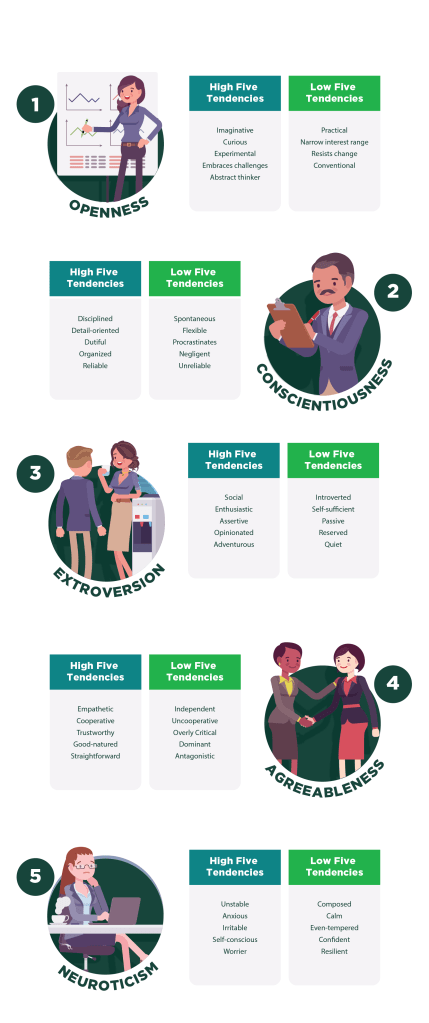Lead Your Team with the Big Five Model
Last Updated January 25, 2022

Effective leaders have a solid understanding of the strengths, weaknesses, motivators and communication styles of every member of their team – and of themselves. Leveraging personality inventories and assessments can help to better understand – and hopefully improve – individual and overall team effectiveness. In many organizations, the DISC model has been well received and adapted to meet various needs. In academic research circles, perhaps the most well-known and scientifically validated personality model is the Big Five model. Understanding the Big Five personality traits in the workplace can provide you with a more holistic approach to assessing, managing and leading your team.
What is the Big Five?
The Big Five, also known as the Five-Factor Model or OCEAN Model (OCEAN being an acronym of the five traits in the model), is built on five dimensions or clusters of personality variances. In the 1930s, American psychologists Gordon Allport and S. Odbert formed a research framework around the “lexical hypothesis” of deriving a comprehensive taxonomy of human personality traits by sampling language. They landed on some 4,500 adjectives that could describe observable personality traits.
Subsequent psychological researchers furthered the theory, whittling down the descriptor list, with Raymond Cattell’s Sixteen Personality Factor Questionnaire, and researchers Ernest Tupes and Raymond Christal later landing on five broad personality factors. In 1985, Paul Costa and Robert McCrae of the National Institutes of Health published their NEO Personality Inventory, with Oliver John of the Berkeley Personality Lab and Verónica Benet-Martinez, psychology professor at the University of California at Davis, releasing the Big Five Inventory (BFI) in 1998.
Finding the Five in Your Team
The Big Five model’s cluster of traits are defined as basic tendencies, separate from a character adaptation that would occur as a result of the tendency, with each of the five personality factors representing a range between two extremes. Correlating highly to a Big Five tendency, as opposed to its opposite extreme, is generally thought to be positive (with the exception of neuroticism), though most people fall somewhere in between the high and low ends of each personality dimension. These traits express themselves as characteristics in individual actions and behaviors.
Applying the Big Five as a Leader
The evidence-based and scientifically researched Big Five model has been shown to produce largely consistent results that can be used to predict some form of a person’s likely achievement, behaviors and even dating choices, according to Simine Vazire, psychology professor at the University of California at Davis.
As research from the Academy of Management indicates, Big Five personality traits can correlate to job performance outcomes. Many job roles and tasks can activate specific traits, and understanding who possesses those traits compatible with a position’s roles and responsibilities enables you to build a high-performing team.
For example, you may find individuals in roles requiring innovation and creativity (graphic designer, creative director, digital content developer, etc.) tend toward openness, rather than more conventional thinkers. Allowing imagination and curiosity to thrive for these team members can be crucial for their workplace success and engagement. When it comes to building team culture, those high in extroversion may prefer social group activities, like team happy hours or participating in company-sponsored sports teams. Someone who is conscientious may prefer connecting through focused, one-on-one conversations to develop individual and team goals.
If you have a diverse team falling across the full spectrum of the Big Five model, it’s likely you can’t take a one-size-fits all approach in your leadership style, as you’ll need to tease out the strengths of each individual and strike an appropriate balance as a leader. For example, your agreeable team member will almost always think with a team-first mentality, but it’s important to make sure their cooperation and empathy isn’t used by those high in assertive, opinionated traits.
In turn, it’s just as important as the leader to understand where your personality traits fall in the Big Five model. A mercurial leader with vacillating emotions can negatively impact a team’s performance. If you’re high in openness be careful in how you communicate with those with greater conscientiousness. Your preferred creative process and abstract thinking may bristle a more structured, detail-oriented subordinate.
Understanding how your team stacks up on the Big Five model can help you identify and mentor likely leaders, align tasks to the team members who will be most adept in handling them, and set your team up for success by ensuring individuals are in roles where they can thrive. As a leader, you’ll want to make sure you have a flexible, agile management approach to adapt your style and strategies across the range of Big Five personality tendencies.
Michigan State’s M.S. in Management, Strategy and Leadership examines diverse management styles and leadership theories to equip you to lead innovative, high-performing teams.


